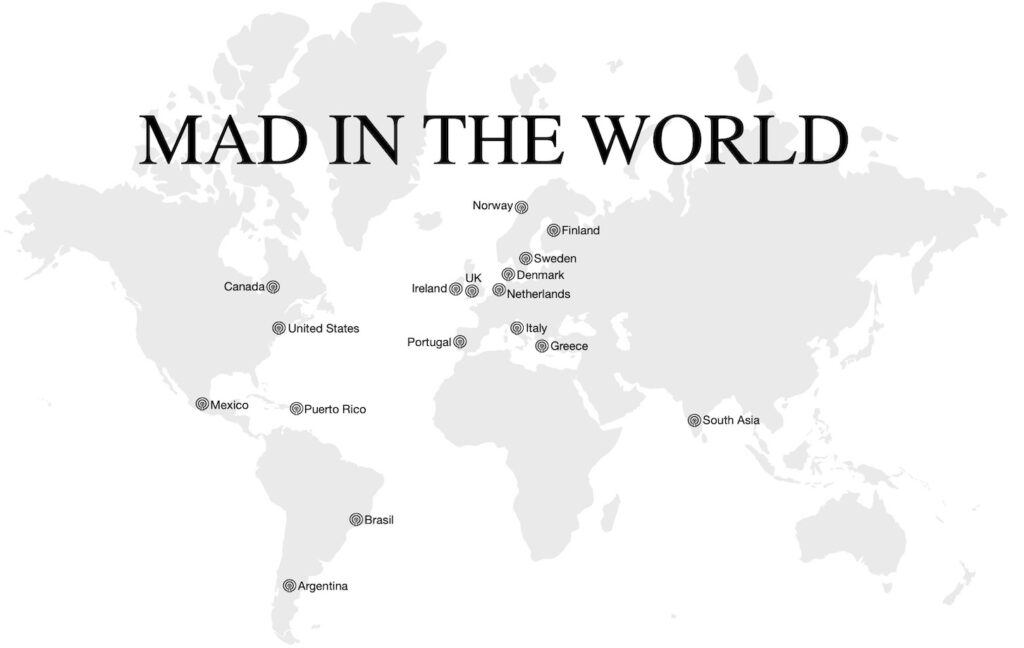The following is a Q&A with the team members who edit and run Mad in (S)pain. Launched first as Mad in Hispanohablante in October of 2016, the Mad in America affiliate shifted its focus to Spain specifically last June. They answered questions as a collective via email.
How would you describe the state of the psychiatric/mental health system in Spain at the moment? How and where does the biomedical paradigm prevail?
In too many places: in primary care services, when the general practitioner sends to mental health services or gives mediation to anyone who consults for suffering; in mental health services (centers, hospitals…); in institutions of confinement (long-stay centers, prisons, juvenile centers) and in popular culture, which understands that the only correct way to deal with suffering is to diagnose, medicate and hospitalize.

How would you describe the influence of pharmaceutical companies?
It is not very different from the rest of Western countries: they finance studies, give direct aid to doctors, influence training, journalism…. The profits made by pharma are so important that they use all their weapons to ensure that the medicalisation of all life’s problems cannot be questioned.
To what extent are alternative approaches available to people?
There is a lot of information about what is happening in other countries, but very few alternatives. It is interesting—for example, the spread of mutual support groups and the Mad Pride movement. However, there are no alternatives for care outside the mental health system as in other countries.
What needs to change?
At the macro level, there must be a radical change in the way mental suffering is understood and cared for. It should also change the fact that the biomedical system is a dogma, and make room for other ways of dealing with distress. We should stop diagnosing all problems and giving pills to everyone, from children to the elderly.
On a micro level we believe that small changes that make a difference could be: helping people to discontinue psychotropic drugs, respecting people’s choices about the care they want to receive, banning mechanical restraint in public health services, increasing the number of mutual support groups, alternatives to hospitalization.
Why did you seek to form an affiliate of Mad in America? What motivated that decision?
We knew Robert Whitaker, and we had told him on occasion that it would be interesting if the important content published in Mad in America could reach the Spanish-speaking public (hence the “Hispanohablante”).
How and why did you originally launch as Mad in Hispanohablante?
Before launching the project, a group of us—readers of Mad in America, concerned about promoting a change in mental health in our country—were working together on other projects, such as the organization of the VII World Congress of Intervoice in Spain. After that, we wanted to continue working on other projects and we organized ourselves as a collective.
What motivated the decision to become Mad in (S)pain?
After years of traveling, and the appearance of other local affiliates, we thought we couldn’t be “colonialist” and speak from Spain to all Spanish-speaking countries. We focused on what was happening in our country with the intention of leaving space for other projects to emerge in Latin America. And in fact, a short time later, Mad in Mexico was born, and we are very happy about that.
What are the individual “origin stories” of the founders/publishers? What are your backgrounds and involvement in psychiatry?
Some of us are or have been mental health service users, or survivors of psychiatry. Others of us are professionals in health and social services. We are also relatives of people who have had bad experiences with psychiatry… In short: I would say that our shared origin story is that of a group of people involved in pushing for a change in the way mental health is cared for and aware that there are other ways that are more respectful of people.
How did you come to challenge the current mental health paradigm?
I don’t know if we have challenged the current mental health paradigm 😉 But we have built a website that offers alternatives, information, and points out the violence that takes place under the cover of the psychiatric system, and that has been important for many people.
How many people are involved in editing and administration? Who is on the team, and who edits the published stories and/or takes care of other tasks?
It has changed over time. We are currently an editing/administration team of seven people. We usually do the tasks between all the members of the team, without differentiating roles. When it is necessary to edit a story, we do it in collaboration with the person who wrote it.
How do you make it all work?
We have fortnightly meetings and we organize together the work that needs to be done: communication with authors, the content we want to prioritize, social networks… and we also share what is happening in the field of mental health in our territory.
You’re all volunteers, and work without funding. Is that correct?
That’s right. None of us in the Mad in (S)pain team receive any remuneration for our work. Nor do we receive any funding for the maintenance of the project. Like other affiliates, we rely on the technical support of Mad in America for hosting the website and access to communication and support tools.
Do you expect to have funding in the future?
We don’t think it is necessary to maintain the project. On some occasions we have thought about it for activities that bring people together, such as the film festival, but never for the development of the project.
How do you feel about being part of the Mad in the World network?
I think it’s wonderful. It is an opportunity to create community, to exchange experiences and to feel that we are many people in many places pushing for a much needed change.
Your logo is “madness, community and human rights.” How would you describe your mission?
We say “madness” because we think it is a word that in our language has much more dignity and comes closer to describing a common human experience than “mentally ill,” and “community” because no one cures anyone and no one heals alone. We can only face the suffering generated by our society together, in common. And “human rights” because we find it incomprehensible that in the field of mental health, fundamental human rights (such as freedom of decision, movement, opinion, etc.) are not respected and we have to point out that diagnosed people are also people with the same rights.
What do you hope to achieve with Mad in Spain in general?
To contribute to a change in the culture of mental health.
And specifically?
To offer information, tools and experiences that demonstrate other ways of dealing with people’s suffering. To point out the violence that is exercised by the mental health system.
In terms of those goals, how important are translations of Mad in America and other global content?
(They) bring readers in our country closer to what is happening and what is being thought in other places. There is a lot of interesting material in research and experience that is produced in English and in our country it is not very common for people to read in English.
How about content specific to Spain, such as personal stories from people with lived experience?
We believe it is very important to open up mental health narratives and in that sense, people’s stories have always been a priority for us. In our experience, they have a lot of impact on readers.
And research from Spain?
We would like to publish more research done in Spain, but most of what is produced in our country is done under the biomedical paradigm. In fact there is not much funding for research in our country, and this is a worrying issue. We tend to publish more international research to encourage the production of our own research and the replication of studies adapted to our reality.
What about other content?
Information on medicines is the most visited content on our website. We believe it is very important for people taking medicines to have comprehensive and reliable information about what they are taking.
What type of content would you like to add?
We are working on the production of a podcast that will be released very soon.
What kind of impact have you seen so far? Comments from readers?
We don’t have comments enabled on the website because we don’t have anyone on the team who can handle moderation. But our content is shared on social media, where there are comments and discussions. References to our website have also been included in publications, papers, books, conferences and congresses.
Have you had responses (including negative ones) from the psychiatric sector?
We haven’t had much, to be honest.
Are there other signs of impact?
For a long time we have had an average of 30,000 visits per month. Now, with the change to Mad in (S)pain and positioning issues, we have lost some visits, but we hope to regain our impact very soon.
What additional impact do you foresee for the future? What are your objectives and goals?
That the project is sustained. That new people come to the editing team with new energy and new ideas. We believe that for the project to continue, we need to have younger people and adapt our content to current modes of communication. We would also like to have more authors.
What gives you hope?
That right now mental health is in the public debate because of the effects of the COVID pandemic. We are hopeful that this will help to change things.














